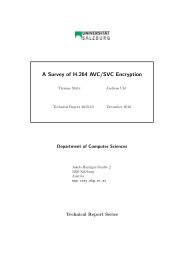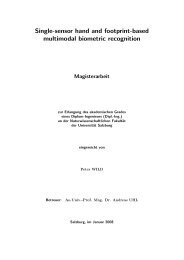Pit Pattern Classification in Colonoscopy using Wavelets - WaveLab
Pit Pattern Classification in Colonoscopy using Wavelets - WaveLab
Pit Pattern Classification in Colonoscopy using Wavelets - WaveLab
Create successful ePaper yourself
Turn your PDF publications into a flip-book with our unique Google optimized e-Paper software.
1 Introduction<br />
endoscope represents a significant advance <strong>in</strong> colonoscopic diagnosis as it provides images<br />
which are up to 150-fold magnified. This magnification is possible through an <strong>in</strong>dividually<br />
adjustable lens. Images taken with this type of endoscope are very detailed as they uncover<br />
the f<strong>in</strong>e surface structure of the mucosa as well as small lesions.<br />
To visually enhance the structure of the mucosa and therefore the structure of an eventual<br />
tumorous lesion, a common procedure is to spray <strong>in</strong>digo carm<strong>in</strong>e or methylen blue onto<br />
the mucosa. While dye<strong>in</strong>g with <strong>in</strong>digo carm<strong>in</strong>e causes a plastic appearance of the mucosa,<br />
dye<strong>in</strong>g with methylen blue helps to highlight the boundary of a lesion. Cresyl violet, which<br />
actually sta<strong>in</strong>s the marg<strong>in</strong>s of the pit structures, is also often sprayed over a lesion. This<br />
method is also referred to as sta<strong>in</strong><strong>in</strong>g.<br />
1.2 <strong>Pit</strong> patterns<br />
Diagnosis of tumorous lesions by endoscopy is always based on some sort of stag<strong>in</strong>g, which<br />
is a method used to evaluate the progress of cancer <strong>in</strong> a patient and to see to what extent a<br />
tumorous lesion has spread to other parts of the body. Stag<strong>in</strong>g is also very important for a<br />
physician to choose the right treatment of the colorectal cancer accord<strong>in</strong>g to the respective<br />
stage.<br />
Several classification methods have been developed <strong>in</strong> the past such as Duke’s classification<br />
system, the modified Duke stag<strong>in</strong>g system and, more recently, the TNM stag<strong>in</strong>g system (Tumor,<br />
node, metastasis).<br />
Another classification system, based on so-called pit patterns of the colonic mucosa, was<br />
orig<strong>in</strong>ally reported by Kudo et al. [16, 30]. As illustrated <strong>in</strong> figure 1.1 this classification<br />
differentiates between five ma<strong>in</strong> types accord<strong>in</strong>g to the mucosal surface of the colon. The<br />
higher the type number the higher is the risk of a lesion to be malignant.<br />
While lesions of type I and II are benign, represent<strong>in</strong>g the normal mucosa or hyperplastic<br />
tissue, and <strong>in</strong> fact are nontumorous, lesions of type III to V <strong>in</strong> contrast represent lesions<br />
which are malignant.<br />
Lesions of type I and II can be grouped <strong>in</strong>to non-neoplastic lesions, while lesions of type<br />
III to V can be grouped <strong>in</strong>to neoplastic lesions. Thus a coarser group<strong>in</strong>g of lesions <strong>in</strong>to two<br />
<strong>in</strong>stead of six classes is also possible.<br />
There exist several studies which found a good correlation between the mucosal pit pattern<br />
and the histological f<strong>in</strong>d<strong>in</strong>gs, where especially techniques us<strong>in</strong>g magnify<strong>in</strong>g colonoscopes<br />
led to excellent results [23, 27, 28, 29, 42, 17].<br />
As depicted <strong>in</strong> figure 1.1 pit pattern types I to IV can be characterized fairly well, while<br />
type V is a composition of unstructured pits. Table 1.1 conta<strong>in</strong>s a short overview of the ma<strong>in</strong><br />
characteristics of the different pit pattern types.<br />
Figure 1.2 aga<strong>in</strong> shows the different pit pattern types, but this time <strong>in</strong> the third dimension.<br />
This makes it easier to understand how the different pit pattern types develop over time.<br />
2








